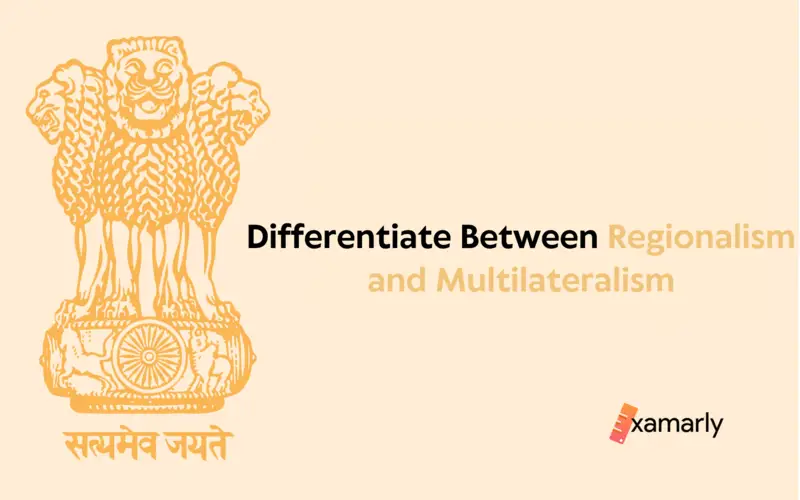An Overview
We will cover all the important aspects related to regionalism and multilateralism and also will also differentiate between regionalism and multilateralism.
We will cover in detail both concepts explicitly and will reflect on some of their features.
Let us dive deep into the article and get to know everything.
Regionalism – In Detail
Regionalism is the cooperation and integration among countries within a specific geographic region. The concept of regionalism has been around for centuries, but it has become increasingly important in the modern era as countries have sought to address common challenges and take advantage of new opportunities.
Different Types Of Regionalism
There are many different forms of regionalism, each with its own unique characteristics and goals. Some of the most common forms include:
- Economic regionalism: This is focused on creating economic integration among countries within a region. This can include free trade agreements, customs unions, and common markets. The goal is often to increase trade and investment among countries, which can lead to economic growth and development.
- Political regionalism: This is focused on creating political cooperation and integration among countries within a region. This can include alliances, defence pacts, and regional organizations. The goal is often to promote stability and security within the region and to enhance the region’s influence on the global stage.
- Cultural regionalism: This is focused on promoting cultural exchange and understanding among countries within a region. This can include cultural festivals, educational exchange programs, and cultural heritage preservation. The goal is often to promote mutual understanding and cooperation among countries within the region.
- Environmental regionalism: This is focused on addressing environmental challenges that cross national borders within a region. This can include agreements on air and water pollution, conservation of natural resources, and protection of endangered species. The goal is often to protect the environment and promote sustainable development within the region.
- Security regionalism: This is focused on addressing security challenges that cross national borders within a region. This can include agreements on counter-terrorism, peacekeeping, and non-proliferation. The goal is often to promote stability and security within the region.
Some Advantages Of Regionalism
Regionalism can bring many benefits to countries within a region, such as increased economic growth and prosperity, improved security, and enhanced cultural understanding. However, it also has its challenges, such as disagreements on policy, differing levels of economic development, and potential tensions between regional and national interests.
Overall, regionalism is a complex and multi-faceted concept, with different forms and goals that can vary widely depending on the specific context of the region.
Some Prominent Examples of Regionalism
- The European Union (EU) – It is a political and economic union of 27 member states in Europe.
- The North American Free Trade Agreement (NAFTA) – It is a trade agreement between Canada, Mexico, and the United States.
- The Association of Southeast Asian Nations (ASEAN) – It is a regional organization promoting economic, political, and security cooperation among 10 Southeast Asian countries.
- The African Union (AU) – It is a political and economic union of 55 African countries.
- The Union of South American Nations (UNASUR) – It is a regional organization promoting integration and cooperation among 12 South American countries.
- The Gulf Cooperation Council (GCC) – It is a political and economic union of six Middle Eastern countries.
- The Southern Common Market (MERCOSUR) – a regional trade agreement between Argentina, Brazil, Paraguay and Uruguay.
- The Caribbean Community (CARICOM) – It is a regional organization promoting cooperation among 15 Caribbean countries.
These are just a few examples, there are many other regional organizations and agreements around the world. Each of them has different goals and objectives, but they all aim to promote cooperation and integration among countries within a specific region.
Multilateralism – In Detail
Multilateralism refers to cooperation among multiple countries or parties on a global or international level.
This can include international organizations, such as the United Nations, or agreements such as the World Trade Organization.
The goal of multilateralism is often to address global challenges, such as poverty and climate change, that cannot be effectively addressed by individual countries acting alone.
Multilateralism has been a key feature of the international system since the end of World War II, with many countries recognizing the need for collective action to address common challenges.
The United Nations, established in 1945, is the most prominent example of multilateralism in practice, with its member countries coming together to address a wide range of issues, from peace and security to human rights and sustainable development.
The World Trade Organization (WTO) is another key example of multilateralism. Established in 1995, the WTO promotes free trade among its member countries through a system of rules and agreements.
The organization helps to resolve trade disputes and provides a forum for negotiating new trade agreements.
Multilateralism also takes place in a regional context as well, with regional organizations such as the European Union and the African Union, working to address challenges and opportunities that are specific to their region.
You Might Also Like – Difference Between Capitalist and Socialist Economy
Advantages Of Multilateralism
Multilateralism has many advantages, such as providing a platform for collective action to address global challenges, promoting international cooperation and understanding, and increasing the participation of smaller and weaker countries in the international system.
However, it also has its challenges, such as difficulties in reaching a consensus among a large number of countries, and potential tensions between the interests of developed and developing countries.
Overall, multilateralism is a complex and evolving concept, with different forms and goals that can vary widely depending on the specific context and the issues at hand.
Despite its challenges, many countries continue to see the value of multilateralism as a means of addressing global challenges and promoting international cooperation and understanding.
Some Key Features Of Multilateralism
- Participation of multiple countries: Multilateralism involves the participation of multiple countries, rather than just one or a few.
- Collective decision-making: Decisions are made through consensus or majority vote, rather than by a single country.
- International organizations: Multilateralism often involves the use of international organizations, such as the United Nations, to facilitate cooperation between countries.
- Cooperation on global issues: Multilateralism is often used to address global issues, such as climate change, poverty, and security.
- Promotion of international law: Multilateralism emphasizes the importance of international law and the rule of law in international relations.
- Focus on cooperation and diplomacy: Multilateralism emphasizes the importance of cooperation and diplomacy in resolving international conflicts and achieving common goals.
Some Prominent Examples of Multilateralism
- The United Nations (UN) – It is an international organization established in 1945 to promote peace and security, human rights, and economic and social development.
- The World Trade Organization (WTO) – It is an international organization established in 1995 to promote free trade and the reduction of barriers to trade among member countries.
- The International Monetary Fund (IMF) – It is an international organization established in 1944 to promote international monetary cooperation and exchange rate stability, and to provide financial assistance to member countries in need.
- The World Bank – It is an international organization established in 1944 to promote economic development and reduce poverty in developing countries.
- The Paris Agreement – a global agreement reached in 2015 under the United Nations Framework Convention on Climate Change (UNFCCC) to combat climate change and to accelerate and intensify the actions and investments needed for a sustainable low-carbon future.
- The Vienna Convention for the Protection of the Ozone Layer – an international treaty signed in 1985 to protect the ozone layer by phasing out the production and consumption of ozone-depleting substances.
- The Biological Weapons Convention – an international treaty signed in 1972 to prohibit the development, production, and stockpiling of biological weapons.
These are just a few examples, there are many other multilateral agreements and organizations around the world that are working to address global issues and promote cooperation among nations.
Let us now differentiate between Regionalism and Multilateralism
Regionalism and multilateralism are both forms of international cooperation, but they have some key differences:
- Geographic scope: Regionalism refers to the cooperation and integration among countries within a specific geographic region, while multilateralism refers to cooperation among multiple countries or parties globally.
- Membership: Regional organizations tend to have a smaller number of member states compared to multilateral organizations, and the membership is usually limited to countries within a specific region. Multilateral organizations, on the other hand, tend to have a larger number of member states from around the world.
- Objectives: Regional organizations usually have specific objectives that are tailored to the specific needs and challenges of the region, such as promoting economic integration, security cooperation, or cultural exchange. Multilateral organizations, on the other hand, tend to have more broad-based objectives, such as promoting peace and security, human rights, and economic and social development.
- Decision-making process: Regional organizations tend to have a more streamlined decision-making process, with a smaller number of member states and a greater emphasis on consensus-building. Multilateral organizations, on the other hand, tend to have a more complex decision-making process, with a larger number of member states and a greater emphasis on representation and democracy.
- Flexibility: Regional organizations tend to be more flexible, which allows them to adapt to changing circumstances and respond quickly to emerging issues. Multilateral organizations, on the other hand, tend to be more bureaucratic and less able to adapt to changing circumstances.
Summing Up
In summary, regionalism is a form of cooperation among countries within a specific geographic region, usually with specific goals and objectives tailored to the region, while multilateralism is a form of cooperation among multiple countries or parties globally, usually with broad-based goals and objectives.
FAQs
What is the main difference between regionalism and multilateralism?
The main difference between regionalism and multilateralism is the geographic scope and membership. Regionalism refers to the cooperation and integration among countries within a specific geographic region, while multilateralism refers to cooperation among multiple countries or parties globally. Regional organizations tend to have a smaller number of member states compared to multilateral organizations, and the membership is usually limited to countries within a specific region.
What are the benefits of regionalism?
Regionalism can bring many benefits to participating countries, such as increased trade and economic integration, improved security cooperation, and cultural exchange. It can also help to address common challenges and promote shared interests within a specific region.
What are the benefits of multilateralism?
Multilateralism can bring many benefits to participating countries, such as promoting peace and security, human rights, and economic and social development globally. It can also help to address global challenges such as climate change and poverty and promote shared interests among nations.
What are some examples of regional organizations?
Some examples of regional organizations include the European Union (EU), the North American Free Trade Agreement (NAFTA), the Association of Southeast Asian Nations (ASEAN), the African Union (AU), the Union of South American Nations (UNASUR), the Gulf Cooperation Council (GCC), the Southern Common Market (MERCOSUR), the Caribbean Community (CARICOM)
What are some examples of multilateral organizations?
Some examples of multilateral organizations include the United Nations (UN), the World Trade Organization (WTO), the International Monetary Fund (IMF), the World Bank, the Paris Agreement, the Vienna Convention for the Protection of the Ozone Layer, and the Biological Weapons Convention.
Can regionalism and multilateralism coexist?
Yes, regionalism and multilateralism can coexist and complement each other. Regional organizations can serve as a building block for a multilateral cooperation, by promoting cooperation and integration within a specific region and serving as a model for cooperation at the global level.






